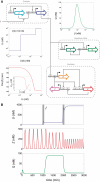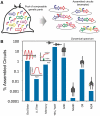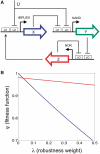Computational design of synthetic regulatory networks from a genetic library to characterize the designability of dynamical behaviors
- PMID: 21865275
- PMCID: PMC3203596
- DOI: 10.1093/nar/gkr616
Computational design of synthetic regulatory networks from a genetic library to characterize the designability of dynamical behaviors
Abstract
The engineering of synthetic gene networks has mostly relied on the assembly of few characterized regulatory elements using rational design principles. It is of outmost importance to analyze the scalability and limits of such a design workflow. To analyze the design capabilities of libraries of regulatory elements, we have developed the first automated design approach that combines such elements to search the genotype space associated to a given phenotypic behavior. Herein, we calculated the designability of dynamical functions obtained from circuits assembled with a given genetic library. By designing circuits working as amplitude filters, pulse counters and oscillators, we could infer new mechanisms for such behaviors. We also highlighted the hierarchical design and the optimization of the interface between devices. We dissected the functional diversity of a constrained library and we found that even such libraries can provide a rich variety of behaviors. We also found that intrinsic noise slightly reduces the designability of digital circuits, but it increases the designability of oscillators. Finally, we analyzed the robust design as a strategy to counteract the evolvability and noise in gene expression of the engineered circuits within a cellular background, obtaining mechanisms for robustness through non-linear negative feedback loops.
Figures







 (blue), illustrating the cost of robustness.
(blue), illustrating the cost of robustness.Similar articles
-
Robust synchronization control scheme of a population of nonlinear stochastic synthetic genetic oscillators under intrinsic and extrinsic molecular noise via quorum sensing.BMC Syst Biol. 2012 Oct 26;6:136. doi: 10.1186/1752-0509-6-136. BMC Syst Biol. 2012. PMID: 23101662 Free PMC article.
-
AutoBioCAD: full biodesign automation of genetic circuits.ACS Synth Biol. 2013 May 17;2(5):230-6. doi: 10.1021/sb300084h. Epub 2012 Nov 26. ACS Synth Biol. 2013. PMID: 23654253
-
A fast, robust and tunable synthetic gene oscillator.Nature. 2008 Nov 27;456(7221):516-9. doi: 10.1038/nature07389. Epub 2008 Oct 29. Nature. 2008. PMID: 18971928 Free PMC article.
-
Network design meets in silico evolutionary biology.Biochimie. 2010 Jul;92(7):746-52. doi: 10.1016/j.biochi.2010.04.003. Epub 2010 Apr 23. Biochimie. 2010. PMID: 20399826 Review.
-
Foundations for the design and implementation of synthetic genetic circuits.Nat Rev Genet. 2012 May 18;13(6):406-20. doi: 10.1038/nrg3227. Nat Rev Genet. 2012. PMID: 22596318 Review.
Cited by
-
Atypical PKCs in memory maintenance: the roles of feedback and redundancy.Learn Mem. 2015 Jun 15;22(7):344-53. doi: 10.1101/lm.038844.115. Print 2015 Jul. Learn Mem. 2015. PMID: 26077687 Free PMC article.
-
De novo automated design of small RNA circuits for engineering synthetic riboregulation in living cells.Proc Natl Acad Sci U S A. 2012 Sep 18;109(38):15271-6. doi: 10.1073/pnas.1203831109. Epub 2012 Sep 4. Proc Natl Acad Sci U S A. 2012. PMID: 22949707 Free PMC article.
-
Systematic design methodology for robust genetic transistors based on I/O specifications via promoter-RBS libraries.BMC Syst Biol. 2013 Oct 27;7:109. doi: 10.1186/1752-0509-7-109. BMC Syst Biol. 2013. PMID: 24160305 Free PMC article.
-
Microbial production of small peptide: pathway engineering and synthetic biology.Microb Biotechnol. 2021 Nov;14(6):2257-2278. doi: 10.1111/1751-7915.13743. Epub 2021 Jan 18. Microb Biotechnol. 2021. PMID: 33459516 Free PMC article. Review.
-
Bridging the gap: a roadmap to breaking the biological design barrier.Front Bioeng Biotechnol. 2015 Jan 20;2:87. doi: 10.3389/fbioe.2014.00087. eCollection 2014. Front Bioeng Biotechnol. 2015. PMID: 25654077 Free PMC article. Review.
References
-
- Elowitz MB, Leibler S. A synthetic oscillatory network of transcriptional regulators. Nature. 2000;403:335–338. - PubMed
-
- Gardner TS, Cantor CR, Collins JJ. Construction of a genetic toggle switch in Escherichia coli. Nature. 2000;403:339–342. - PubMed
-
- Atkinson MR, Savageau MA, Myers JT, Ninfa AJ. Development of genetic circuitry exhibiting toggle switch or oscillatory behavior in Escherichia coli. Cell. 2003;113:597–607. - PubMed

